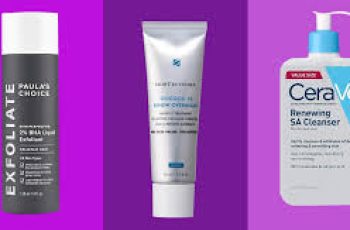
Stem Cells vs Growth Factors vs Exosomes In Skin Care
This is a guide that explains the difference between human stem cells vs growth factors vs exosomes in face serums.
There are many antiaging ingredients, and it can get confusing and hard to decide which are the best for you to use on your face.
It would be a shame for you to buy an expensive antiaging serum and then waste your money by use it incorrectly or using it in the wrong step of the skincare routine.
And guess what?
Most stem cell or growth factor skin care products are not worth the money!
I am a skin care expert and I can guide you to find the best antiaging products with stem cells, growth factors or exosomes for your skin type.
Take the free quiz and get a personalized custom skin care routine. We will tell you exactly what step to use stemcells, growth factors and exosomes in your skin care routine and what other products to layer them with.
All you need to do is take the skin care routine quiz and hop by your Baumann Skin Type.®
Take the Quiz
Stem cells vs growth factors vs exosomes in antiaging skin care
Human Stem Cells in Serums
Problems with Stem Cells in Skin Care Products
Human Growth Factors in Serums
Problems with Growth Factors in Skin Care
Exosomes
Why exosomes are better than stem cells and growth factors
References
Stem cells vs growth factors vs exosomes in antiaging skin care
This can be hard if you do not understand the science. This blog explains the difference between stem cells, growth factors and exosomes.
Note that this article only discusses human growth factors. Growth factors and stem cells from plants such as apples are a complete waste of money. We are not apples, our skin is completely different than apple skin, and we do not need the same growth factors they do. So just forget about apple stem cells and do not waste money buying them. They are not worth it.
Exosomes made by stem cells
Human Stem Cells in Serums
There are different layers of skin. Each skin layer has different types of cells and therefore different types of stem cells.
The human derived stem cells that are found in skincare products are stem cells from:
Keratinocytes in the epidermis
Fibroblast from the dermis
The hair follicle
Body Fat
Umbilical chords
Placenta
The function of the stem cell and the signals, growth factors, and exosomes they give off is determined by which layer and cell type they come from.
We will focus on stem cells in the dermis because these are more important in antiaging skin care products because they make:
Collagen
Elastin
Hyaluronic acid
Glycosaminoglycans
Other important cell components
In the skin’s dermis, stem cells turn into mature fibroblasts. Lots of research has shown us that stem cells, when placed in wounds in in cell cultures, change the way the cells around them act. They do this by releasing exosomes and growth factors like TGF-beta. (Exosomes also contain growth factors).
This is why stem cells have been used in antiaging skin care and wound therapy for many years. It is undisputable that they have dramatic effects and naturally occurring stem cells in the skin are important to have young skin.
However, there are problems with stem cells in skin care products.
Problems with Stem Cells in Skin Care Products
There are many reasons that stem cells in skin care are not good. This first is that when they are plant derived stem cells such as apple stem cells, they do not carry the correct cell signals that human skin needs to increase collagen production and block the causes of aging such as cellular senescence.
Here are more reasons that stem cells do not work:
Human stem cells must come from fat, bone marrow, placenta, skin biopsies, cell cultures and other biologic material.
This is expensive
FDA is changing requirements for use
May not be safe- it depends on the source
Stem cells do not live in the skin product bottles and jars. They die quickly
Topically applied stem cells cannot get down into the dermal layer of the skin to perform their functions
For these reasons, stem cells in topical antiaging skin creams are worthless and not worth the money.
Human Growth Factors in Serums
Growth factors are secreted by many cell types, including stem cells. They are signaling molecules used in cell-to-cell communication. Once growth factors are excreted by cells, they then must move through the extracellular matrix between cells to get to the target cell. Once at the target cell, growth factors bind a receptor on the target cell so the target cell can “hear” the signals of the growth factor.
Each type of growth factor has a different message, target receptor, and action that is causes. For example, some growth factors cause more blood vessels to form, while others stimulate cells to make more collagen. Growth factors work best in groups, with each playing its role. The best growth factor to get skin to increase collagen production is TGF-beta.
There are many types of growth factors in human skin. Find a list of growth factors used in skin care here.
Problems with Growth Factors in Skin Care
Many growth factor serums are either not worth the money, don’t work, or have safety issues.
The problem with growth factors in skin care products are:
Growth factors may not be safe such as EGF.
They may not remain active in a skin cream that has sat on the shelf for months
They get broken down before they reach the target tissue
You need the right combination of growth factors to cause the desired results
We often do not know which growth factors are actually in the skin care products
Old skin cells cannot “hear” them. (Heparan sulfate helps this problem)
Exosomes
Exosomes are protective spheres known as extracellular vesicles that contain many signaling molecules including growth factors. They are little spherical capsules surrounded by a bilayer membrane. Their function is to hold signaling molecules in a safe environment and deliver them directly to the target cell.
New data has shown that the beneficial effects of stem cells actually occur because of the exosomes that stem cells secrete. In fact, applying the exosomes instead of stem cells has the same effect! So new science has shown us that it is the exosome containing the growth factors that is important, not the stem cell.
In this video I discuss exosomes and skin aging with a Regenerative Medicine Dermatologist and a Transplant Cardiologist who have done a lot of research on the rejuvenation effects of exosomes. They developed the exosome skin care line known as Plated Skin Care.
Exosomes are better than stem cells and growth factors in antiaging skin care
Exosomes are secreted from stem cells, They carry growth factors, RNA and other cell signals. Exosomes protect the growth factors and carry them directly to the target cells.
Exosomes carry important molecules such as:
mRNA
micro RNA
growth factors
immune signals
So the answer is exosomes are better than growth factor and stem cells serums. Exosomes contain growth factors and are what is in stem cells that gives stem cells skin rejuvenation properties.
The best exosomes are derived from platelets and umbilical chords because these carry the cell signals needed for wound healing and production of structural cellular components like collagen and glycosaminoglycans.
But the real question is- do you need an exosome serum? Or should you be using a different antiaging ingredient such as retinoids?
Well- it depends upon your Baumann Skin Type.
Don’t guess on what skin care serums to buy. Let us help you shop for antiaging skin care products using your Baumann Skin Type.


